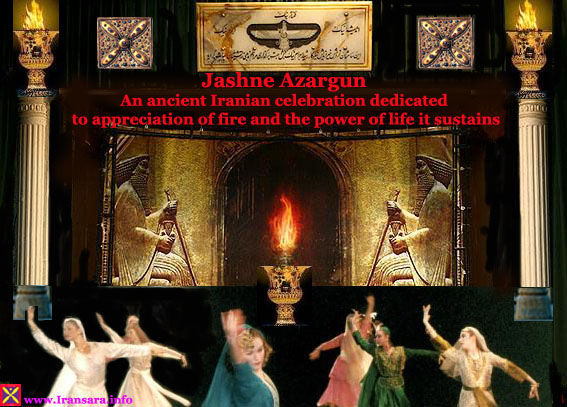
Jashne Azargun
Ancient Iranian Celebration
9 Azar Maah 6372
Shahanshahi (Federalism)

Jashne Azargun is an ancient Iranian celebration and reflects the rich cultural heritage of Iran. Jashne Azargun is celebrated during the Persian month of Azar and is dedicated to a profound appreciation of fire and the power of life it sustains. Azar in Persian language means fire and it is certain that in ancient Iran the fire played a most prominent role. The capturing of fire and fire making techniques were developed by ancient Iranians in around 7000 BCE. Having learned to make fire at will, life took a different turn for ancient Iranians, winters become comfortable, nights were light up, food becomes palatable, metal was extracted and tools made. In short, the possibility to control fire changed the life of ancient Iranians thereby many impressive temples were constructed and inconceivable pains were taken to preserve the sacred element from defilement. They looked upon fire as a manifestation of the divine power, purity, and essence. Fire was carried in state processions before the Persian kings at glorious palaces, for it was a symbol of the divine presence and the national feeling. Traditional Jashne Azargun celebration includes gathering around fire with family and friends for a holiday feast.
Fire compared to air, water or earth has a mystical effect. It gives one the feeling of spiritual elevation. Concentrating on the flickering flames it mesmerizes and relaxes the mind. It helps the mind enter the Alpha stage where the mind works at its best. With all these qualities it is but natural for fire to be elevated to the position of a communication facilitator with God. In ancient Iran from the earliest times the care of the fire was so meticulous and so elaborately developed that it formed the most noticeable characteristic of the ancient Iranians. They were called by their enemies "fire-worshipers". These statements from different periods in history, all try to discount the propaganda that ancient Iranians, namely Zartoshtians, were fire worshipers, or that they worshiped fire instead of God, and that the teachings of the Great Zartosht the sage of ancient Iran had anything to do with worshiping fire. But this propaganda continues to this day and is used by opponents to divert attention from the real teachings of the Great Zartosht, which they fear.
Mapendar ke atash-parast bodand Parastandeh pake yazdan bodand
Think not of them as fire worshipers For of God they were pure worshipers"The Great Ferdowsi"
"Ferdowsi in his epic "Shahnameh", attributes the important 'art of lighting a fire' to Houshang Shah of the Pishdadian dynasty. He recounts how one day Houshang was traveling with his army when he sees a huge snake, he throws a stone to kill it, but misses and instead hits another stone and sparks a fire. From this incidence the Iranians learned how to light a fire at will."
In ancient Iran being able to partially control fire was a boon. It was but natural that soon a organization be formed around this important element that changed their life. The wise among them studying the fire and making rules for its safe upkeep, the average people following these rules as rituals. Even today simple things in our daily life are controlled by sets of rules and regulations, we follow them most of the time without questioning their legitimacy. Very soon we get so used to it that they become part of our daily rituals.
Iranian History, Culture and Festivals inspire the world!
Dorood to Iran, Iranians and Farhange Iran
It is time for IRANIANS to be True IRANIAN